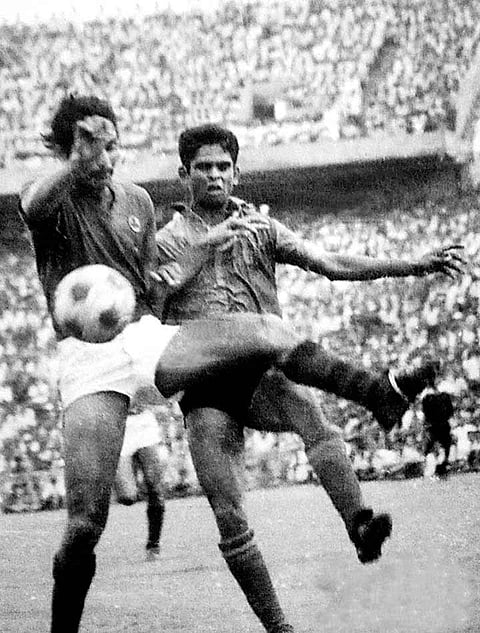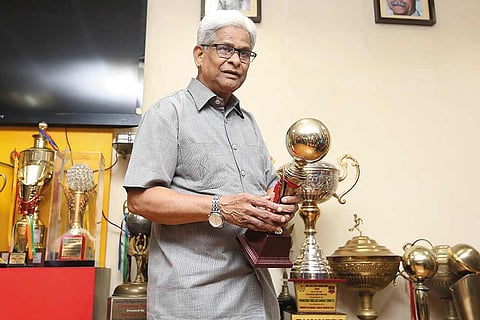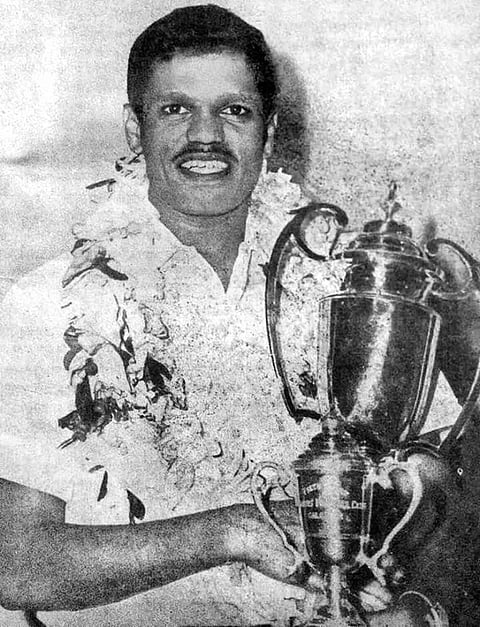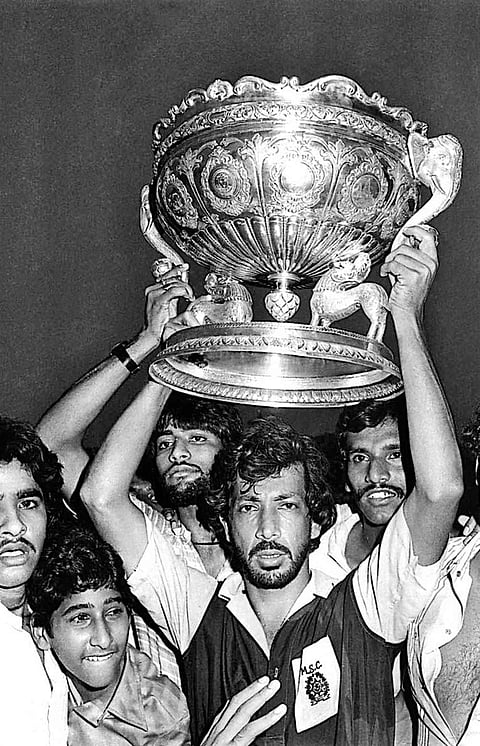How do empires—not merely of realms but those springing from a fount of exceptional skill—wane? By what slowly unfolding turn of fate does a rich vein of inspiration and influence attenuate into barrenness? The nourishing current that made Hyderabad a powerhouse of Indian football has abandoned that once fecund stream, leaving behind a tract rich in tradition and memory. Consider this: when Andhra (Hyderabad till 1958) defeated Bengal one-nil to win the Under-19 national crown for the Dr B.C. Roy Trophy in 1976—its last national football title—Bhaichung Bhutia was just born. It won the Santosh Trophy thrice and twice in succession, produced a team like Hyderabad City Police that clinched a record five Rovers Cups on the trot and produced over a dozen top players for two successive Olympic and national teams. Our vaunted golden era of football in the ’50s belonged to Hyderabad.
Hyderabad Back On Indian Football Map But Can It Rise From The Ashes?
More than a dozen footballers in India's Olympic teams of the Fifties came from Hyderabad. The city now has a team in the ISL but yesteryear superstars like Rahim Sahab, Balaram, Habib and Nayeemuddin are completely forgotten
Just like its astonishing rise and dominance, Hyderabad’s precipitous decline was a great setback to the progress of football in India. Yet, between 1950 and 1963 when Hyderabad City Police (later Andhra Police) lifted the Rovers Cup a staggering nine times and landed four Durand titles, the bulk of India’s top players were bred in the heart of the Deccan plateau.
Hyderabadis like Tulsidas Balaram, Kannan, Salam, Syed Nayeemuddin, Mohammed Habib and his younger brother Mohammed Akbar, Shabbir Ali and others set the Calcutta Maidan ablaze in a firestorm of panache and skill.

A glorious Md Habib in action.
Now, decades after its glorious past, the Nizam’s jewel is making more of a ‘commercial’ return to the football scene when Hyderabad FC plays its first match of the Indian Super League against ATK in Calcutta on October 25. Yet the ‘return’ is an ersatz one. The ISL, born in October 2014 and managed by the All India Football Federation’s commercial partners, Reliance, included Hyderabad FC after Pune FC disbanded due to a financial crisis. The ISL, now accorded the status of India’s premier league, is a high-budget, jazzy affair that has left teams like Pune and Delhi Dynamos financially crippled. Without a single ‘local’ footballer, Hyderabad FC has to sustain itself and whet ‘home’ support when it plays its matches at the Gachibowli Stadium.
Syed Hakim, a member of the 1960 Rome Olympics squad and a former regional director of Sports Authority of India, doesn’t see ISL doing much for Hyderabad’s revival. “It’s dead; Hyderabad football is completely buried,” he says. Hakim adds that the modern generation does not remember Noor, Balaram, Habib, Azizuddin or a Moinuddin—ilustrious men who represented India in multiple Olympics and Asian Games. “Hyderabadis only remember cricket, tennis or badminton stars,” Hakim laments. It was, indeed, telling that Mohammed Azharuddin launched Hyderabad FC’s jersey. “We had no clue about the jersey launch,” says Shabbir Ali, who scored a record 23 goals for India in 72 matches during 1972-84. Shabbir, like Habib, lives in Hyderabad.
After the British introduced the game at the end of the 18th century, football took firm hold of Secunderabad, a cantonment area. Youths from Risala Bazaar, Trimulghery, Gun Rock and Ammuguda formed teams with names like Shining Star, Club of Nawabs & Jagirdars, Eleven Hunters and Merry Go Round. Competition increased when teams from the Old City area joined the fray. The clubs were patronised by prosperous theatre owners and wealthy men, including the last Nizam, Nawab Mir Osman Ali Khan.

Habib at the East Bengal club.
But the one man who personified Hyderabad’s footballing supremacy in those years was Syed Abdul Rahim, or Rahim Sahab—visionary coach, legendary disciplinarian, talent spotter of genius, exemplary shaper of players and one of the architects of modern Indian football.
The sport got a leg up, too, when Gymkhana School, Nizam College and Osmania University started playing serious football. In 1939, the Hyderabad Football Association was born. In 1943, Rahim became the secretary. Hyderabad Police’s Ashe Gold Cup victory against Royal Air Force in 1943 was a turning point.
Rahim’s amazing ability to churn out quality players made Hyderabad a potent threat to the troika ruling Indian football then— Bengal, Bangalore and Services. They made consecutive Santosh Trophy finals in 1949 and 1950, losing both times to Bengal in Calcutta. A style of play that fused vigorous power with great skill, Hyderabad played league matches lasting 90 minutes when others like Bengal and Kerala played a maximum of 70. Hyderabad went on to win the Santosh Trophy twice in succession—1956 and 1957. A third came in 1965.

The cerebral T. Balaram was one of the best strikers in Asia.
“His (Rahim) work ethics made players stronger and disciplined,” reminisces Syed Nayeemuddin, who captained India in the 1970 Merdeka Cup and later that year the Asian Games in Bangkok, the last time India won a bronze. “The work-rate of players used to be unbelievable, and it was always for the love of the game. It was never for money,” he adds, highlighting the pride that Rahim instilled in every player—club or nation. As coach, Rahim was far ahead of his times. Having studied the European giants, especially Puskas’s Hungary, Rahim introduced a trailblazing 4-2-4 system in India, whereas most teams in Europe and elsewhere favoured the 2-3-2-3 formation, later transitioning to 3-3-4 in the 1950s. In Rahim’s scheme, the forward withdrew to the half-line, helping in building up and providing an extra defender. It was later adopted by clubs around the world. Rahim’s international record is an intrinsic part of his mythical aura. Leading India in three Olympics, he saw his team get knocked out in Helsinki in 1952 after a 1-10 loss to Yugoslavia. Having prepared well, India bamboozled opponents in 1956 in Melbourne, losing to Bulgaria in the third-place match. Rahim coached India in its last-ever Olympic in 1960 (India have never qualified since) in Rome, finishing sixth, including a 1-1 draw against France.
In the Asiads, Rahim planned India’s gold-winning display in Delhi, in 1951. His final accomplishment came on September 4, 1962, during the Jakarta Asiad. In a ‘David vs Goliath’ contest, India outclassed South Korea 2-1 at the Senayan Stadium in front of 1,00,000 spectators. That team had four Hyderabadis—Peter Thangaraj, Tulsidas Balaram, Yousuf Khan and Afzal. It is said that Rahim’s tactical break-down of the Korean strategy made the players believe in themselves. It was Rahim’s last bow—nine months later, on June 11, 1963, lung cancer carried him away. He was 53. None of his boys knew of his illness on that memorable night in Jakarta.
On his death bed, Rahim had apparently predicted the imminent rise of teams like Iran, Japan and the Koreas, who were close to reaching world standards then. True to his words—all three are among the best in Asia, while India are not even in FIFA’s top 100 football-playing nations. Though Rahim’s demise ended a celebrated chapter of Hyderabad football, till 1986, 21 Hyderabadis participated in the Asian Games.

Shabbir Ali posing as the hero of a shield win during his heyday.
A steady decline, however, had set in. Veteran commentator Pradip Roy says Hyderabad’s loss was Bengal’s gain. “Once they made the Santosh Trophy finals and started doing well in Rovers, Durand and DCM, their players were being monitored by Calcutta clubs. East Bengal, Mohun Bagan and Mohammedan Sporting had excellent scouts and…everyone wanted to play in the ‘big three’. Their style was appreciated and stardom was guaranteed,” says Roy.
Although it was risky to quit their jobs with the police, starting from the early ’60s, a clutch of top Hyderabad players turned out for the ‘big three’. While two-time Olympian Balaram will figure among the greats of Indian football, the brothers Habib and Akbar made a name for themselves too. The stylish defending of handsome Nayeem, playing in his signature red leather boots, the wiry Shabbir’s acrobatic headers and Victor Amalraj’s energetic mid-field prowls are treasured memories of old fans for whom football was a way of life.
“How can one forget Akbar’s 17-second goal for Mohun Bagan in the derby against East Bengal at the Eden Gardens in 1976? After the kickoff Prasun Banerjee’s quick pass to Ulganathan at the left-wing corner took Sudhir Karmakar, at the heart of East Bengal defence, by surprise. Akbar’s brilliant header to Ulga’s cross provided the only goal of the match,” remembers Roy.
The diminutive Habib was a master tactician—his relentless creativity and vision made him any team’s fulcrum. “If Akbar made a name, it was due to his elder brother,” says Roy. One of Habib’s best performances came against Pele’s New York Cosmos at the Eden on September 24, 1977. Habib made it 2-1 for Mohun Bagan in the 33rd minute. The match ended 2-2 after Cosmos were gifted a controversial spotkick.
Now 70 and suffering from Parkinson’s, Habib rarely speaks to the media, but fondly reminisces his partnership with Akbar. “He made me love the game. We played for years and that helped create understanding. We need players to play together for long to develop a relationship. Then the goals will come,” says Habib.
Hyderabad football was hit by the exodus of top players seeking greater challenges. For Kannan, Ahmed Hossain, Salam etc, stardom, not money, was the greater lure. Balaram, now in his mid-80s, worked for the railways and Shabbir retired from Allahabad Bank.
Hyderabadis figure prominently in Indian football’s glory years. Our football is destitute of world-class achievements for long; modern-day football administrators have to draw lessons from how these greats won all that silverware.
***
Santosh Trophy
- 1956 Hyderabad - Champion
- 1957 Hyderabad - Champion
- 1965 Andhra - Champion
Rovers Cup
- 1950-1954 Hyderabad Police - Champion
- 1957 Hyderabad Police - Champion
- 1960 Andhra Police - Champion
- 1962 Andhra Police & East Bengal - Joint Champions
- 1963 Andhra Police - Champion
Note: Hyderabad Police is the only team in India to win the Rovers Cup five years in a row (1950-54)
Durand Cup
- 1950 Hyderabad Police - Champion
- 1954 Hyderabad Police - Champion
- 1957 Hyderabad Police - Champion
- 1961 Andhra Police - Champion
DCM Trophy
- 1959 Central Police Lines (Hyderabad) - Champion
- 1965 Andhra Police - Champion
Dr BC Roy Trophy*
- 1966 Andhra - Champion
- 1976 Andhra - Champion
*National Junior Championship (U-19)
Sait Nagjee Trophy
- 1958 Andhra Police - Champion
- 1950 Andhra XI - Champion
Note: Hyderabad was renamed Andhra in 1958